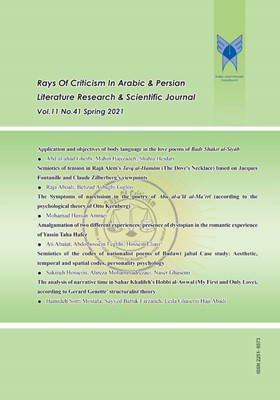Semiotics of tension in Rajā Alem's Tavq al-Hamām (The Dove's Necklace) based on Jacques Fontanille and Claude Zilberberg’s viewpoints
Subject Areas : Literary criticismRaja Abuali 1 , Behzad Asbaghi qiqlo 2 *
1 - Assistant Professor of Arabic Language and Literature at Allameh Tabatabae'i University, Tehran, Iran
2 - Graduate student of Arabic Language and Literature of Allameh Tabatabae'i University, Tehran, Iran
Keywords: Tensive semiotics, post- colonialism, Claude Zilberberg, Rajā Alem, Tavq al-Hamām (The Dove's Necklace), Jacques Fontanille,
Abstract :
Semiotics is basically a general theory of significations. Its main objective is to enter a literary text such as a novel to throw light on its darknesses and to distinguish the different features of that text, so that the semiotician can extract the foundations of analytic criticism. Therefore, tensive semiotics is, on the one hand, relies on the separation of ambition from possibility and realization, while it is based on the tension between power and distance. On the other hand, the tension is an imaginary place that produces reactions of essence and conscience to the material world along with the temporal, spatial and quantitative features. In the present study that stresses on descriptive-analytic method, the novel Tavq al-Hamām (The Dove's Necklace) by Rajā Alem, the Saudi Arabian novelist, is studied and criticized according to tensive semiotics through the study of most important semiotic elements of the novel and the characters of the society of Mecca in the post-colonial era. The results of the study show that the tensive semiotics led to the emergence of tension between characters and events in the novel. so that, the tension reaches the point in which the reader doesn’t understand the events or understands something else from the intension of the author. It is concluded from the present study that based on tensive semantic, the ‘whys’ of the theory in the novel lead to the distinction of some of the main values within tension between culture and civilization, all that to attest the severity of and the distance between these two. We also concluded that the main aspects, the internal and the external intention, and the essence that is comprehended and pronounced is a great cause of the tension between culture and civilization in Mecca.
إنتروفرن، فریق. (2012م). التحلیل السیمیائي للنصوص. ترجمة: جریر، حبیبة. ط1. دمشق. سوریة: دار نینوی.
بنفنست، إمیل. (لاتا). سیسیولوجیا اللغة. ترجمه: سیزا، قاسم. ط1. القاهرة: دار إلیاس العصریة.
جنیت، جرار. (1997م). خطاب الحکایة (بحث في المنهج) . المترجمون: معتصم، والآخرون. ط2. لامک: المجلس الأعلی للثقافة.
حمداوي، جمیل. (2015مa). الإتجاهات السیمیوطیقیة (التیارات والمدارس السیمیوطیقة في الثقافة الغربیة). ط1. لامک: مکتبة المثقف.
حمداوي، جمیل.(2017م). الجدید في السیمیوطیقا (من المربع المنطقي إلی المبیان التوتري). ط1. المغرب: لانا.
حمداوي، جمیل. (2015مb). مدخل إلی السیمیوطیقا السردیة. ط1. المغرب: مکتبة المثقف.
حمداوي، جمیل. (2014م). من سیمیوطیقا الذات إلی سیمیوطیقا التوتر. ط1. المغرب: الدار البیضاء.
حمداوي، جمیل. (2011م). نظريات النقد الأدبي في مرحلة مابعدالحداثة. ط1. المغرب: لانا.
زواوي، مختار. (2019م). من المورفولوجیات إلی السيميائيات. ط1. الأردن: العالم الکتب الحدیث للنشر والتوزیع.
السمري، إبراهیم عبدالعزیز. (2011م). اتّجاهات النّقد الأدبي العربي في القرن العشرین. ط1. القاهرة: دار الآفاق العربیة.
شارودو، باتریک؛ منغنو، دومینیک. (2008م). معجم تحلیل الخطاب. ترجمة: المهیري، عبدالقاهر. ط1. تونس: دار سنیاترا.
عالم، رجاء. (2011م). طوق الحمام. ط3. المغرب: الدار البیضاء.
مجدي، وهبة ؛ المهندس، کامل. (1984م). معجم المصطلحات العربیة في اللغة والأدب. ط2. بیروت: مکتبة لبنان.
Benveniste, Emil. (1996) . Problemes de linguistique generale. Paris.Gallimard.
Fontanille, Jacques; Zilberberg,Claude. (1998). Tensionetsignification. Liege .p . Mardaga.
_||_
